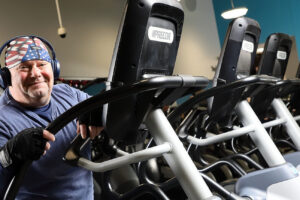For people with peripheral artery disease (PAD), walking can be a painful experience, so it may seem counterintuitive to prescribe an exercise program to alleviate pain. However, a simple treatment approach can help patients overcome PAD and get back to an active lifestyle.
Peripheral artery disease develops when plaque builds up in the arteries that carry blood to your head, limbs and organs. Plaque is made up of calcium, fat, fibrous tissue, cholesterol and other materials in the blood. Over time, plaque can harden and narrow the arteries, limiting the flow of oxygen-rich blood to your organs and other parts of your body.
When a patient has PAD, the goal is to prevent cardiovascular events, such as stroke and heart attack, and to improve walking ability and function. To treat PAD, the first step is to stop smoking and proactively manage any chronic conditions like high blood pressure, high cholesterol and diabetes. If necessary, more invasive treatment options are available, such as revascularization via endovascular approaches using balloons and stents.
CentraState’s Endovascular Lab provides state-of-the-art, minimally invasive surgery for non-cardiac vascular conditions such as clogged, collapsed or otherwise compromised blood vessels. This minimally invasive approach is an excellent alternative to open surgery. Patients with endovascular disease, like peripheral artery disease, often have diabetes and high blood pressure, making their condition more difficult to manage. Minimally invasive techniques often relieve pain faster and reduce the necessity for open surgical repair, promoting healing and shortening recovery time.
Is Supervised Exercise Therapy (SET) Right for Me?
However, supervised exercise therapy is a promising, non-surgical weapon to treat PAD, and its benefits are significant: improved exercise tolerance, more stamina, better quality of life and a reduced probability of having a cardiac event.
You’ll need a formal diagnosis of peripheral artery disease from a referring physician. Diagnostic tests for PAD include an ankle-brachial index (ABI) test, which compares the blood pressure in your foot with the blood pressure in your arm; ultrasound, MRI or CT scan of legs; or an arteriogram, which provides a “road map” of your arteries, locating any blockages.
After diagnosis, if your doctor says you are able to exercise and that it’s safe for you to do so, supervised exercise therapy for PAD is conducted by a nurse at the Cardiac Rehabilitation Center at CentraState Medical Center. The customized program involves walking on a treadmill at a certain incline and speed until you develop mild discomfort, then taking a break until symptoms subside, then restarting.
The program is three times a week for 12 weeks, and participants usually advance from being able to perform 15 to 30 minutes of exercise to 50 to 60 minutes of exercise per day, including warm-up and cool-down time. Once the onsite program concludes, patients are encouraged to exercise on their own at home or a medically-supervised fitness center such as CentraState Fitness and Wellness Center.
Patients who have experienced heart attacks or have had open-heart surgery have been referred to supervised exercise therapy programs for many years and have made great strides in regaining their exercise stamina. Because peripheral artery disease often makes exercise painful, this is a new approach, and while exercise may be uncomfortable at first, the benefits greatly outweigh the initial discomfort. It’s important for referring physicians to understand and advocate for the benefits of this type of exercise program which is now covered by Medicare, and supported by the American Heart Association.
For more information about SET for PAD at CentraState, call 866-CENTRA7.
 Peter Hynes, MD, FSCAI, FACC, RPVI is an interventional cardiologist. He is board-certified in internal medicine, cardiovascular disease, interventional cardiology and endovascular medicine. He is affiliated with CentraState Medical Center and can be reached by calling 866-CENTRA7.
Peter Hynes, MD, FSCAI, FACC, RPVI is an interventional cardiologist. He is board-certified in internal medicine, cardiovascular disease, interventional cardiology and endovascular medicine. He is affiliated with CentraState Medical Center and can be reached by calling 866-CENTRA7.





